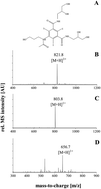A highly sensitive method for quantification of iohexol
Abstract
Iohexol (1-N,3-N-bis(2,3-dihydroxypropyl)-5-[N-(2,3-dihydroxypropyl) acetamide-2,4,6-triiodobenzene-1,3-dicarboxamide) is used for accurate determination of the glomerular filtration rate (GFR) in chronic kidney disease (CKD) patients. However, high iohexol amounts might lead to adverse effects in organisms. In order to minimize the iohexol dosage required for the GFR determination in humans, the development of a sensitive quantification method is essential. Therefore, the objective of our preclinical study was to establish and validate a simple and robust liquid-chromatography-electrospray-mass-spectrometry (LC-ESI-MS) approach using the multiple reaction monitoring mode for iohexol quantification. In order to test whether a significantly decreased amount of iohexol is sufficient for reliable quantification, a LC-ESI-MS approach was assessed. We analyzed the kinetics of iohexol in rats after application of different amounts of iohexol (15 mg to 150 μg per rat). Blood sampling was conducted at four time points, at 15, 30, 60, and 90 min, after iohexol injection. The analyte (iohexol) and the internal standard (iothalamic acid) were separated from serum proteins using a centrifugal filtration device with a cut-off of 3 kDa. The chromatographic separation was achieved on an analytical Zorbax SB C18 column. The detection and quantification were performed on a high capacity trap mass spectrometer using positive ion ESI in the multiple reaction monitoring (MRM) mode. Furthermore, using real-time polymerase chain reaction (RTPCR) the effect of iohexol on early regulated gene expression in thyroid and renal cortex was tested to determine a threshold of physiological active iohexol concentrations. A linear correlation of the iohexol amount and mass-signal (MS) intensity was found in the range of 50 pg to 40 ng (r2 = 0.998). The lowest limit of quantification (LLOQ) was 50 pg. The intra- and inter-day accuracies were between 91.2% and 98.7%. The intra- and inter-day precisions were between 2.7% and 9.2%. The recovery rate of iohexol was determined in the range of 100.8 ± 10.9%. The gene expression test revealed that iohexol dosages exceeding 0.5 mg kg−1 induce a group of genes in thyroidal tissue that comprises transcription factors and genes of cellular stress response. Namely, Ptgs2, Smad7, Jun, Srf, Dusp1, Timp1 and others are up-regulated within 15 min after iohexol i.v. application. This mass-spectrometry based method has been proved to be sensitive, selective and suitable for the quantification of iohexol in serum. Due to high sensitivity of this novel method the iohexol application dose as well as the sampling time in the clinical routine could be reduced in the future in order to further minimize side effects in humans.


 Please wait while we load your content...
Please wait while we load your content...